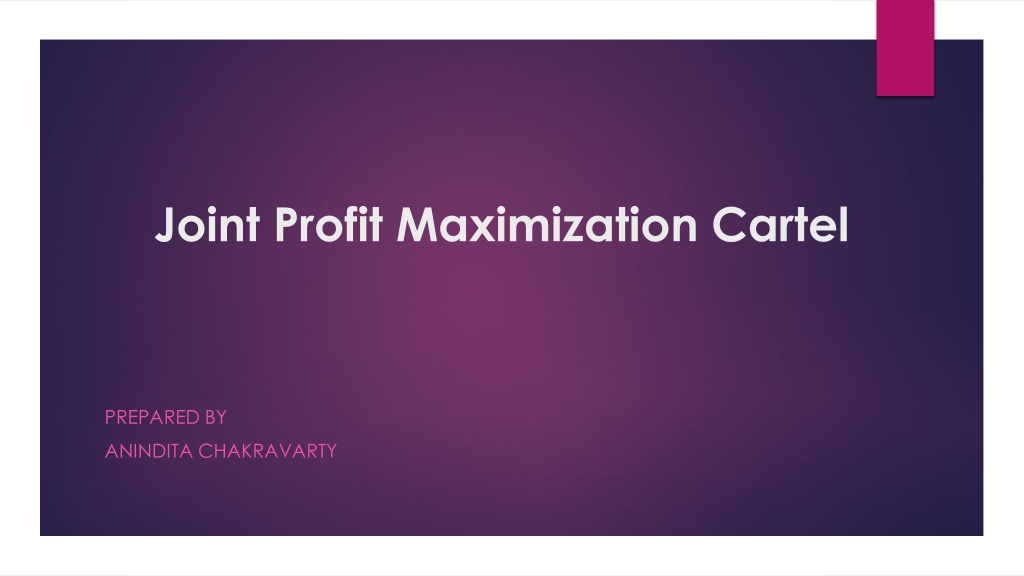Understanding Joint Profit Maximization Cartel
In a joint profit maximization cartel, member firms surrender price and output control to achieve maximum joint profits. The central administrative authority determines output quotas based on cost minimization. The cartel works by aligning industry MR with MC to maximize profits. Advantages include avoiding price wars and maximizing joint profits, but challenges include enforcement and member compliance.
Download Presentation

Please find below an Image/Link to download the presentation.
The content on the website is provided AS IS for your information and personal use only. It may not be sold, licensed, or shared on other websites without obtaining consent from the author. Download presentation by click this link. If you encounter any issues during the download, it is possible that the publisher has removed the file from their server.
E N D
Presentation Transcript
Joint Profit Maximization Cartel PREPARED BY ANINDITA CHAKRAVARTY
INTRODUCTION An extreme form of collusion is found when the member firms agree to surrender completely their rights of price and output determination to a Central Administrative Agency so as to achieve maximum joint profits for the member firms. Formation of such a formal collusion is generally designated as perfect cartel or joint profit maximization cartel. The output quota to be produced by each firm is decided by the central administrative authority in such a way that the total costs of the total output produced is minimum. Total cost will be minimized when the various firms in the cartel produce such separate outputs so that their marginal costs are equal.
Let us now see how the cartel works and determines its price and output decisions. Let us assume that two firms have formed a cartel by entering into an agreement. We assume that the cartel will aim at maximizing joint profits for the member firms.
EXPLANATION Given the market demand curve and its corresponding MR curve, joint profits will be maximized when the industry s MR equals the industry s MC. Figure 3 shows the situation where D is the market (or cartel) demand curve and MR is its corresponding marginal revenue curve. The aggregate marginal cost curve of the industry MC is drawn by the lateral summation of the MC curves of firms A and B, so the MC = MCa + MCb. The cartel solution-that maximizes joint profit is determined at point E where the MC curve intersects the industry MR curve. Consequently, the total output is OQ which will be sold at OP = (QF) price. As under monopoly, the cartel board will allocate the industry output by equating the industry MR to the marginal cost of each firm. The share of each firm in the industry output is obtained by drawing a straight line from E0 to the vertical axis which passes through the curves MCb and MCa of firms B and A at points Eb and Ea respectively. Thus the share of firm A is OQa and that of firm B is OQb which equal the total output OQ (= OQb + OQa). The price OP and the output OQ distributed between A and B firms in the ratio of OQa: OQb is the monopoly solution. Firm A with the lower costs sells a larger output OQa than the firm B with higher costs so that OQa > OQb. But this does not mean that A will be getting more profit than B. The joint maximum profit is the sum of RSTP and ABCP earned by A and B respectively. It will be pooled into a fund and distributed by the cartel board according to the agreement arrived at by the two firms at the time of the formation of the cartel.
Advantages of a Cartel It avoids price wars among rivals. The firms forming a cartel gain at the expense of customers who are charged a high price for the product. The cartel operates like a monopoly organization which maximizes the joint profit of firms. Generally, joint profits are high than the total profits earned by them if they were to work independently.
Problems of a Cartel 1. It is difficult to make an accurate estimate of the market demand curve. This is because each firm thinks that its own demand curve is more elastic than the market demand curve as its product is a perfect substitute for the product of its rivals. 2. The estimation of the market MC curve may be inaccurate because the individual firms may supply low-cost data about their MC to the central cartel board in order to have a larger share of output and profits. 3. The formation of a cartel is a slow process which takes a long time for the agreement to arrive at by firms especially if their number is very large. In the meantime, there may be changes in the cost structure and market demand for the product. 4. The larger the number of firms in a cartel, the less is its chances of survival for long because of the distrust, threatening and bargaining resorted to by them. The cartel will, therefore, break down. 5. In theory, the cartel-members agree on joint profit maximisation. But in practice, they seldom agree on profit distribution.























